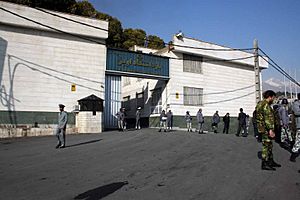Zahra Kazemi facts for kids
Quick facts for kids
Zahra Kazemi
|
|
|---|---|

Kazemi before her arrest (BBC)
|
|
| Born | 1948 Shiraz, Iran
|
| Died | 11 July 2003 (aged 55) Evin Prison, Tehran, Iran
|
| Resting place | Shiraz, Iran |
| Nationality | Iranian-Canadian |
| Education | University of Paris |
| Occupation | Photojournalist |
| Children | 1 |
| Awards | Tara Singh Hayer Memorial Award (2003) |
Zahra "Ziba" Kazemi-Ahmadabadi (Persian: زهرا کاظمی احمدآبادی; 1948 – 11 July 2003) was a brave Iranian-Canadian photojournalist. A photojournalist is someone who tells stories using pictures. She became well-known because she was arrested in Iran and died while being held by Iranian authorities.
Iranian officials said she died by accident from a stroke during questioning. However, a former military doctor named Shahram Azam said he saw her body and found signs that she had been tortured. He later moved to Canada and shared what he knew.
Her death was the first time that someone dying in government custody in Iran got a lot of international attention. Because she was a citizen of both Iran and Canada, and because of how she died, her case became a big international issue, called a "cause célèbre." In November 2003, an organization called Canadian Journalists for Free Expression gave her an award. It was called the Tara Singh Hayer Memorial Award. They gave it to her to honor her courage in defending the right to speak freely.
Who Was Zahra Kazemi?
Zahra Kazemi was born in Shiraz, Iran. In 1974, she moved to France to study literature and movies at the University of Paris. She moved to Canada in 1993 with her son, Stephan Hachemi. They settled in Montreal, Quebec. She later became a Canadian citizen, meaning she had "dual citizenship" (citizenship in two countries).
Zahra traveled a lot for her work. She took photos in Africa, Latin America, and the Caribbean. She also worked often in the Middle East, including the Palestinian territories, Iraq, and Afghanistan. She visited Iraq and Afghanistan both before and during the time the United States was there. Just before her trip to Iran, she had been in Iraq, taking pictures of the U.S. presence.
Her photos often showed important themes. She documented poverty, people forced to leave their homes, and unfair treatment. She also showed the strength of women in difficult situations.
Her Arrest in Iran

Zahra went back to her home country, Iran, using her Iranian passport. She was allowed into Iran to take pictures of possible protests. These protests were expected to happen in Tehran in July 2003. The protests did happen, but they were quickly stopped. Security forces and plainclothes police officers broke them up after six days.
After the protests, about 4,000 students were reported missing. People thought they had been arrested and taken to Evin prison. This prison in Tehran is known for holding political prisoners. It was common for families of missing people to gather outside Evin prison. They hoped to find out what happened to their children.
On June 23, 2003, Zahra drove to the prison to take pictures of these families. She had a press card from the government. She believed this card allowed her to work anywhere in Tehran, including near Evin prison.
According to Shirin Ebadi, a famous Iranian lawyer and Nobel Peace Prize winner, a prison staff member saw Zahra taking photos. He demanded that she give him her camera. Photography is not allowed in front of the prison.
Shirin Ebadi, who later represented Zahra's family, explained what happened next:
- Zahra was worried about the families whose photos she had already taken.
- She quickly exposed her film to the light, ruining the pictures so they couldn't be used.
- The guard got angry and yelled at her. He said he asked for the camera, not for her to ruin the film.
- Zahra replied, "You can have the camera, but the film belongs to me."
- She was then taken into custody and questioned for three days by police and intelligence officers.
The staff at Evin prison said that Zahra was in a sensitive area. They claimed she was photographing parts of the prison itself. A few days after her arrest, some newspapers said she was a spy. They claimed she had entered the country secretly as a journalist. Zahra, however, insisted she only photographed the street and the families protesting, not the prison building.
Her Death in Custody
On July 11, 2003, Zahra Kazemi died. This was nineteen days after she was arrested. She died in Iranian custody at Baghiyyatollah al-Azam Military Hospital. Two days later, Iran's official news agency, IRNA, reported that she had a stroke during questioning and died. This story later changed. They then said she died after falling and hitting her head.
On July 16, 2003, Iran's vice-president, Mohammad Ali Abtahi, admitted the truth. He said Zahra Kazemi died because she was beaten. Mohammad Ali Abtahi and Masoud Pezeshkian, the Minister of Health, both confirmed she died from a fractured skull. This means her skull was broken from being hit in the head. Abtahi later said he was pressured to take back his statement, but he refused.
Shirin Ebadi also reported that security officials searched the house of a friend Zahra was staying with. They kept asking her friend about Zahra's "medical condition" and what medicines she took. Officials also stopped Zahra's elderly mother from seeing her daughter. They questioned her about medicines they insisted Zahra must be using. Zahra's friend later realized this meant Zahra was already dead. The officials wanted to claim that Zahra had a health problem that got worse in prison.
The story of Zahra's death didn't become a huge issue right away. It gained more attention almost two years later. That's when Shahram Azam, the former doctor from Iran's Defence Ministry, made a statement. He said he examined Zahra in the hospital four days after her arrest. He found clear signs that she had been tortured.
After Her Death
In June 2005, there was an exhibition in Montreal at the municipal Côte-Saint-Luc Library. It showed photos Zahra Kazemi had taken during her travels in the Middle East. The exhibition was closed down after some people complained. They said five of her photos showed a "pro-Palestinian bias." These photos showed scenes inside Palestinian refugee camps.
Library officials removed these five photos, but left the rest of the exhibition. Zahra's son, Stephen Hachemi, was upset. He said removing the Palestinian photos was "a violation of my mother's spirit." He demanded that the library either show all the photos or none at all. In the end, the library closed the entire exhibition.
The mayor of Côte Saint-Luc, Robert Libman, told CBC news that the conflict was "very complicated." He said creating an impression that Palestinians were being treated unfairly by the Israeli government was not a "fair portrait." He added that in the future, such politically sensitive work would not be shown at the library.
Many people criticized the decision to close the exhibition. They called it "censorship." Writers Naomi Klein and Aaron Maté said it was "part of a disturbing pattern to silence opposition" to the Israeli occupation of certain territories. The description that came with the photo exhibition said Zahra's photos "illustrated the daily life of Palestinians." It showed the problems they faced as they tried to keep their land and their identity. It spoke of "exodus, poverty, humiliation, suffering, and the ravages of war."
Zahra Kazemi's life was one of the inspirations for a popular webcomic called Zahra's Paradise.
See also
- Human rights in Iran
- List of famous Persian women
- List of foreign nationals detained in Iran
- Zahra Bani Yaghoub

